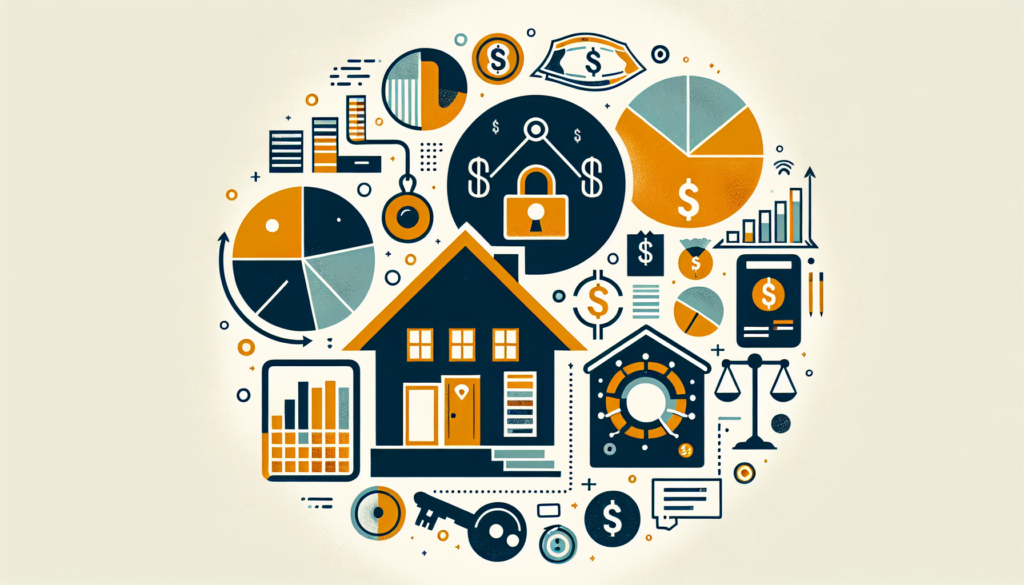If you’ve been dreaming of owning your own home but have been held back by the thought of expensive loans, we’ve got some good news for you. Our article on “Affordable Financing Options for Your Dream Home” is here to guide you towards finding the perfect solution. This friendly and informative piece explores a variety of financing options, ensuring that you’re well-equipped to make the best choice for your unique situation. Say goodbye to overwhelming loan terms and hello to a smooth path towards homeownership. So, let’s dive in and discover how you can turn your dreams into reality.
Affordable Financing Options for Your Dream Home
Congratulations on pursuing your dream of homeownership! Finding the right financing option can seem overwhelming, but fear not – we’re here to help. In this comprehensive guide, we’ll explore various affordable financing options that can make your dream home a reality. From traditional mortgage loans to down payment assistance programs, homebuyer education programs, seller financing, rent-to-own programs, private mortgage insurance, home equity loans and lines of credit, energy-efficient mortgages, and shared appreciation mortgages, we’ve got you covered. So, let’s dive in and explore the options that best suit your needs and budget.

1. Traditional Mortgage Loans
Fixed-Rate Mortgage
A fixed-rate mortgage is the most common type of mortgage loan. With this option, the interest rate remains constant for the entire duration of the loan, typically 15 or 30 years. This provides stability and allows you to plan your budget more accurately.
Adjustable-Rate Mortgage
An adjustable-rate mortgage (ARM) offers a lower initial interest rate that adjusts periodically after an initial fixed-rate period. This type of mortgage is suitable if you plan to move or refinance before the adjustment period begins.
Federal Housing Administration (FHA) Loans
FHA loans are insured by the Federal Housing Administration and are designed to help first-time homebuyers and those with lower credit scores. With a low down payment requirement and flexible qualification criteria, FHA loans can be an excellent option for those who need more flexibility in their financing.
Veterans Affairs (VA) Loans
VA loans are available to active-duty military members, veterans, and their eligible spouses. These loans offer competitive interest rates, no down payment requirement, and are backed by the Department of Veterans Affairs. If you’re eligible, a VA loan can significantly reduce the financial burden of homeownership.
United States Department of Agriculture (USDA) Loans
USDA loans are designed to promote homeownership in rural areas. These loans offer competitive interest rates, require no down payment, and have flexible credit requirements. If you’re looking to purchase a home in a qualifying rural area, USDA loans can help you achieve your dream without breaking the bank.
2. Down Payment Assistance Programs
Federal Home Loan Bank (FHLB) Down Payment Assistance
FHLB provides down payment assistance to low-income and moderate-income homebuyers through member financial institutions. This assistance can come in the form of grants, forgivable loans, or low-interest loans, helping you bridge the gap between your savings and the required down payment amount.
State Housing Finance Agency (HFA) Down Payment Assistance
State HFAs offer down payment assistance programs tailored to the needs of local communities. These programs provide grants or low-interest loans to help eligible homebuyers afford the down payment and closing costs.
Local Government Programs
Many local governments provide down payment assistance programs to support affordable homeownership. These programs can vary from city to city, so it’s worth exploring the options available in your area.
Employer-Assisted Housing Programs
Some employers offer assistance to their employees in achieving homeownership. These programs may provide down payment assistance, favorable mortgage terms, or other financial incentives. Check with your employer to see if they have any housing assistance programs in place.
3. Homebuyer Education Programs
HUD-approved Housing Counseling Agencies
HUD-approved housing counseling agencies offer educational programs to homebuyers. These programs cover topics such as budgeting, credit management, mortgage options, and the homebuying process. By participating in these programs, you can gain valuable knowledge and skills to make informed financial decisions.
First-Time Homebuyer Classes
First-time homebuyer classes are designed specifically for individuals who are new to the homebuying process. These classes cover topics like budgeting, credit improvement, loan types, down payment assistance programs, and more. Attending these classes can give you the confidence and tools needed to navigate the homebuying journey successfully.
Financial Literacy Workshops
Financial literacy workshops focus on building overall financial knowledge and skills. These workshops cover a wide range of topics, from budgeting and saving to understanding credit and managing debt. By enhancing your financial literacy, you can make more informed decisions about homeownership and ensure long-term financial stability.
4. Seller Financing
Owner Financing
Owner financing, also known as seller financing, occurs when the seller of the property acts as the lender. In this arrangement, the buyer makes regular mortgage payments directly to the seller, bypassing traditional lenders. Seller financing can be beneficial if you’re having difficulty obtaining traditional financing or if you’re looking for more flexible terms.
Lease-to-Own Agreements
A lease-to-own agreement allows you to rent a home with the option to purchase it at the end of the lease term. A portion of your monthly rent goes towards building equity, which can later be used for your down payment. Lease-to-own agreements offer flexibility and can be a great option if you’re not ready to commit to a mortgage right away.
Land Contracts
A land contract, also known as a contract for deed or installment sale agreement, allows you to buy a property directly from the owner without traditional financing. In this arrangement, the seller acts as the lender, and you make regular payments directly to them. Once the contract is paid in full, you become the legal owner of the property.

5. Rent-to-Own Programs
How Rent-to-Own Programs Work
Rent-to-own programs allow you to rent a home with the option to buy it in the future. A portion of your monthly rent is set aside as a rent credit, which can be used towards the purchase price. These programs provide flexibility and time to save for a down payment while living in the home you aspire to own.
Pros and Cons of Rent-to-Own Programs
Rent-to-own programs can be advantageous for individuals with limited savings or lower credit scores. They provide an opportunity to improve your financial situation while living in your desired home. However, it’s important to consider the potential drawbacks, such as higher monthly payments and the risk of not being able to secure financing at the end of the rental term.
Rent Credits and Purchase Option Fees
Participating in a rent-to-own program entitles you to rent credits, which accumulate over time and can be used towards the purchase price of the home. Additionally, most programs require a purchase option fee, which grants you the exclusive right to purchase the property within a specified timeframe.
6. Private Mortgage Insurance (PMI)
What is PMI?
Private Mortgage Insurance (PMI) is typically required for conventional loans when the down payment is less than 20% of the property’s value. PMI protects the lender in case the borrower defaults on the loan.
How PMI Works
PMI is an additional cost added to your monthly mortgage payment. The amount of PMI varies depending on factors such as loan amount, down payment, and credit score. It’s important to understand the cost and implications of PMI before choosing this option.
PMI vs. FHA Mortgage Insurance
While PMI applies to conventional loans, FHA mortgage insurance is required for FHA loans. Both serve a similar purpose of protecting the lender in case of defaults, but FHA mortgage insurance has specific requirements and costs associated with it.
Ways to Get Rid of PMI
Once you’ve built sufficient equity in your home, you can take steps to cancel or avoid PMI altogether. This can be achieved through making additional payments towards the principal, refinancing, or when the PMI automatically terminates according to the terms of your loan.

7. Home Equity Loans and Lines of Credit
Home Equity Loans
Home equity loans allow you to borrow against the equity you’ve built in your home. The loan is typically a lump sum paid out and repaid with fixed monthly payments over a set term. These loans can be an affordable financing option if you have significant equity in your home.
Home Equity Lines of Credit
Home equity lines of credit (HELOCs) provide a flexible source of funds that you can access as needed. Similar to a credit card, a HELOC allows you to borrow up to a predetermined credit limit. You only pay interest on the amount you borrow, and you can repay and redraw funds as needed during the draw period.
Pros and Cons of Home Equity Loans and Lines of Credit
Home equity loans and HELOCs offer lower interest rates compared to other forms of credit, as they are secured by your home. However, it’s crucial to consider the potential risks, such as the possibility of losing your home if you default on payments.
Using Home Equity for Your Dream Home
If you have substantial equity in your current home, you can leverage it to finance your dream home. By utilizing a home equity loan or line of credit, you can access the funds needed for a down payment or other expenses associated with purchasing a new property.
8. Energy-Efficient Mortgage (EEM)
What is an EEM?
An Energy-Efficient Mortgage (EEM) is designed to finance energy-efficient improvements in a home. This type of mortgage allows homebuyers to increase their purchasing power and decrease their utility expenses by financing energy-saving upgrades.
Advantages of EEM
By incorporating energy-efficient features into your home, you can reduce energy consumption, lower utility bills, and contribute to a more sustainable environment. Additionally, EEMs may offer competitive interest rates and higher loan limits, allowing you to afford a more energy-efficient home.
EEM Eligibility and Requirements
To qualify for an EEM, you’ll need an energy assessment or audit of the property to determine the potential energy savings. The cost of the improvements can then be added to the mortgage amount. It’s important to work with lenders experienced in EEMs to ensure a smooth financing process.
Financing Energy-Efficient Improvements
EEMs allow you to finance a wide range of energy-efficient upgrades, including insulation, energy-efficient windows and doors, solar panels, and more. Financing these improvements through an EEM can be a cost-effective way to make your dream home more environmentally friendly.

9. Shared Appreciation Mortgages
How Shared Appreciation Mortgages Work
Shared appreciation mortgages (SAMs) are a less common but innovative financing option. With a SAM, the lender provides a portion of the down payment in exchange for a share of the potential future appreciation of the home. This can help you reduce the required down payment while sharing the risk and reward with the lender.
Advantages and Disadvantages of Shared Appreciation Mortgages
SAMs can be advantageous if you have limited savings for a down payment or want to reduce your monthly payments. However, it’s important to carefully consider the potential drawbacks, such as sharing the future appreciation and the complexity of the agreement.
Qualifying for a Shared Appreciation Mortgage
Qualifying for a shared appreciation mortgage typically requires meeting certain credit and income requirements. Lenders may also consider the location and market conditions of the property. It’s essential to thoroughly evaluate the terms and conditions of a SAM before proceeding.
With the variety of affordable financing options available, there’s bound to be a solution that aligns with your goals and financial circumstances. Whether you opt for a traditional mortgage, explore down payment assistance programs, consider seller financing, or investigate other alternatives, don’t hesitate to seek guidance from reputable mortgage professionals. By taking the time to research and understand your options, you’ll be well-equipped to make informed decisions and turn your dream of homeownership into a reality!
